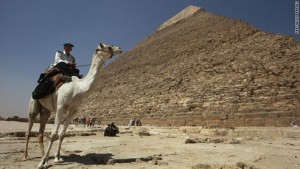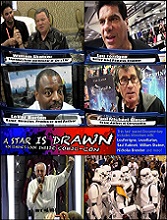[wp_campaign_1]
London, England (CNN) — A robot explorer has revealed ancient markings inside a secret chamber at Egypt’s Great Pyramid of Giza.
Marks found in tiny chamber at the end of a passage date from 4,500 years ago
The painted hieroglyphs and stone markings were filmed using a robot camera
Scholars hope they will explain why the mysterious shafts were built
The markings, which have lain unseen for 4,500 years, were filmed using a bendy camera small enough to fit through a hole in a stone door at the end of a narrow tunnel.

It is hoped they could shed light on why the tiny chamber and the tunnel — one of several mysterious passages leading from the larger King’s and Queen’s chambers — were originally built.
The markings take the form of hieroglyphic symbols in red paint as well as lines in the stone that may have been made by masons when the chamber was being built.
According to Peter Der Manuelian, Philip J. King Professor of Egyptology at Harvard University, similar lines have been found elsewhere in Giza. “Sometimes they identify the work gang (who built the room), sometimes they give a date and sometimes they give guidelines to mark cuttings or directional symbols about the beginning or end of a block,” he said.
CNN Money video: How much would the Great Pyramid cost to build today?
“The big question is the purpose of these tunnels,” he added. “There are architectural explanations, symbolic explanations, religious explanations — even ones relating to the alignment of the stars — but the final word on them is yet to be written. The challenge is that no human can fit inside these channels so the only way to do this exploration is with robots.”
Pictures of the markings have been published in the Annales du Service Des Antiquities de l’Egypte, the official publication of Egypt’s Supreme Council of Antiquities, following an international mission led by the Minister for Antiquities.
The robot explorer that took the images is named Djedi, after the magician whom Pharaoh Khufu consulted when planning the layout of the Great Pyramid. It was designed and built by engineers at the University of Leeds, in collaboration with Scoutek UK and Dassault Systemes, France.
Although robots have previously sent back pictures from within the pyramid’s tunnels, Djedi’s creators say it is the first to be able to explore the walls and floors in detail, rather than just take pictures looking straight ahead, thanks to a “micro snake” camera.
The camera also scrutinized two copper pins embedded in the door to the chamber at the end of the tunnel. In a statement, Shaun Whitehead, of Scoutek UK, said: “People have been wondering about the purpose of these pins for over 20 years. It had been suggested that they were handles, keys or even parts of an electrical power plant, but our new pictures from behind the pins cast doubt on these theories.
“We now know that these pins end in small, beautifully made loops, indicating that they were more likely ornamental rather than electrical connections or structural features. Also, the back of the door is polished so it must have been important. It doesn’t look like it was a rough piece of stone used to stop debris getting into the shaft.”

The team’s next task is to look at the chamber’s far wall to check whether it is a solid block of stone or another door.
“We are keeping an open mind and will carry out whatever investigations are needed to work out what these shafts and doors are for,” said Whitehead. “It is like a detective story, we are using the Djedi robot and its tools to piece the evidence together.”
[wp_campaign_1]





